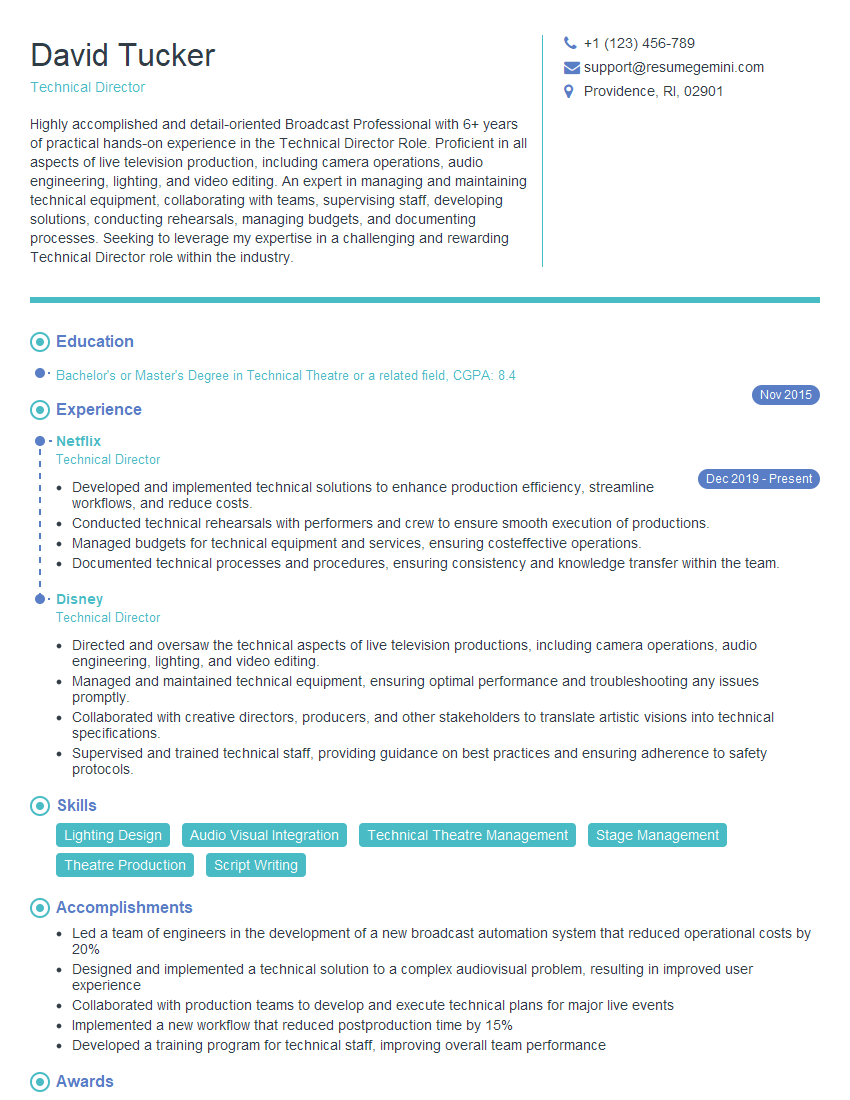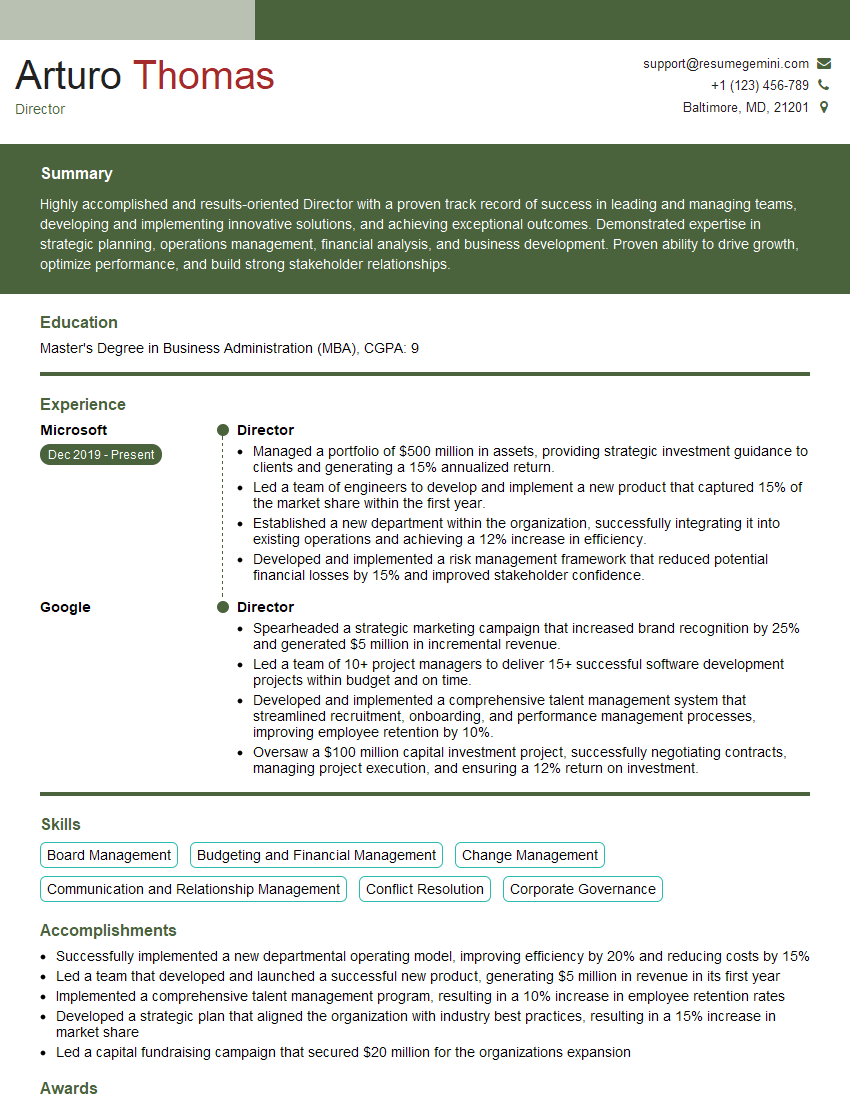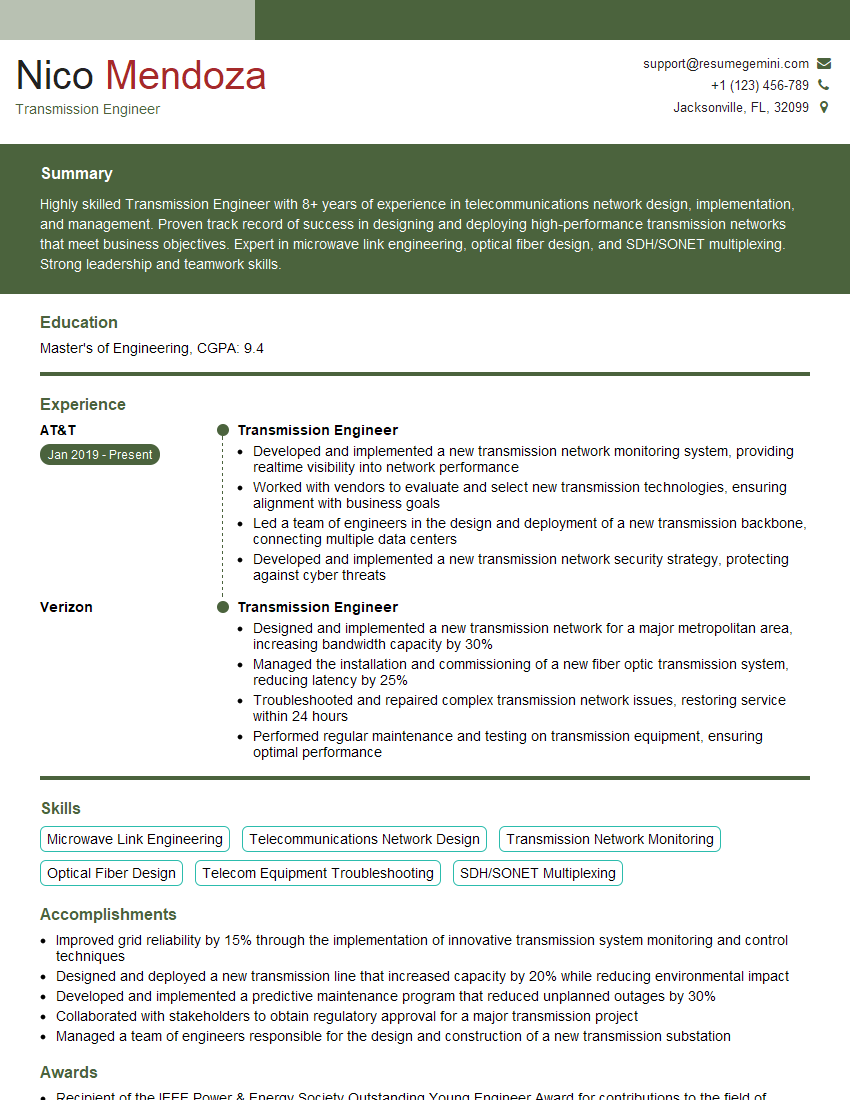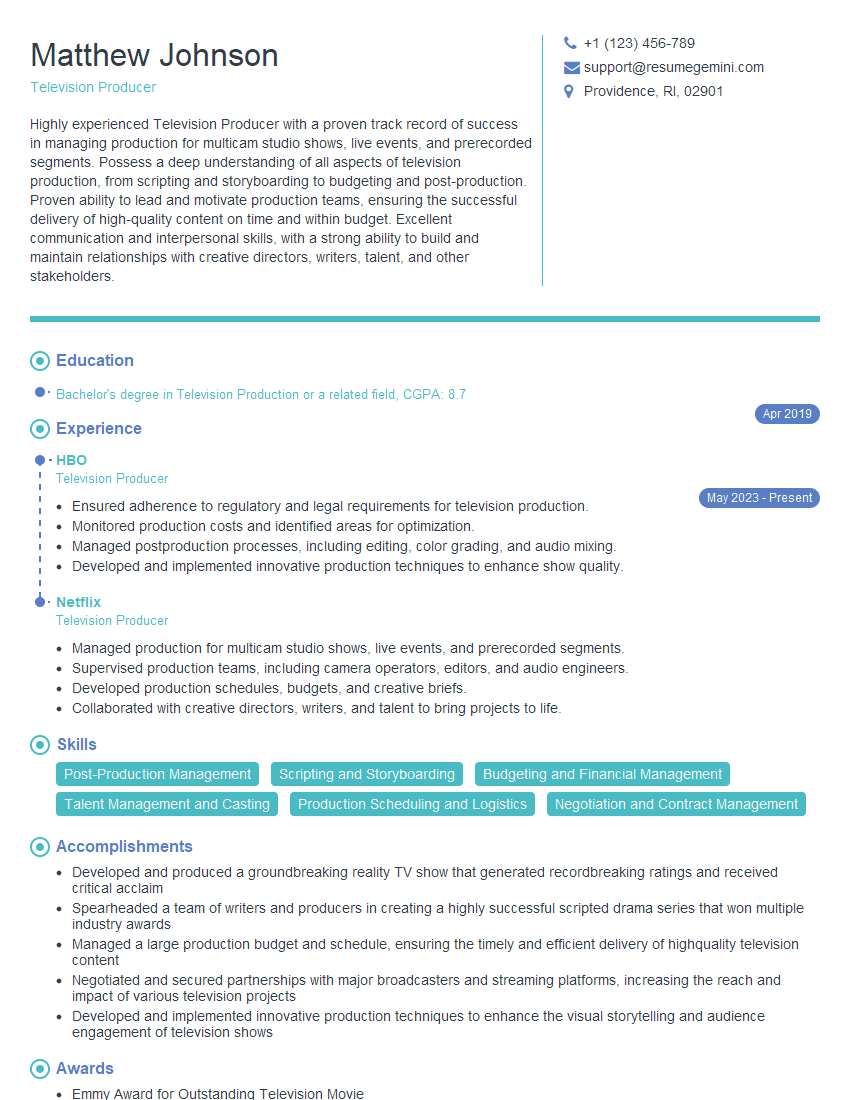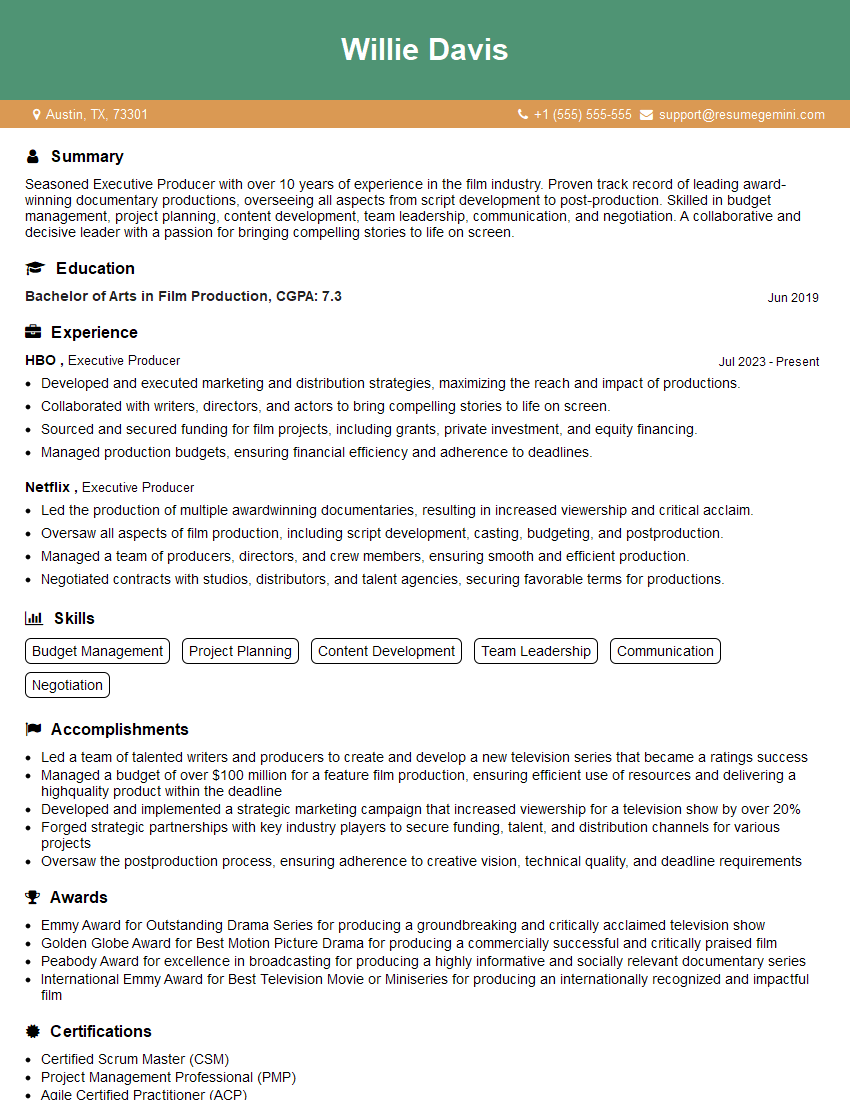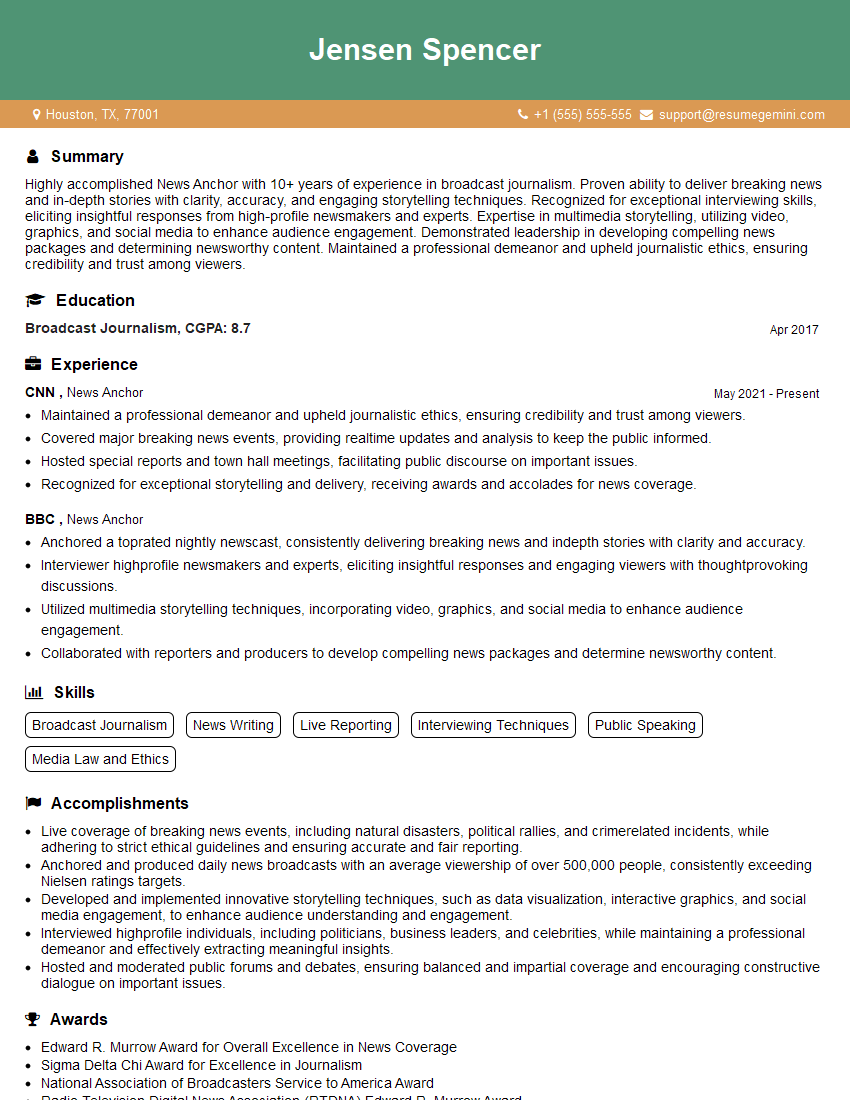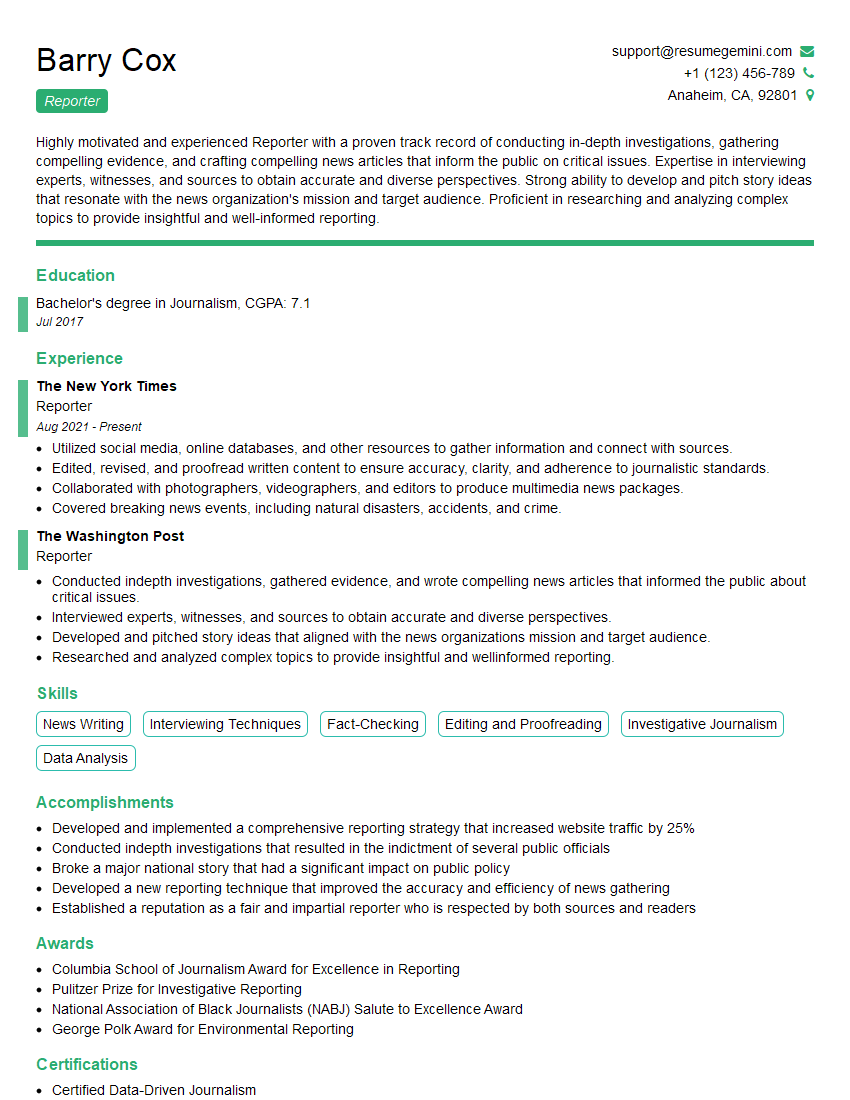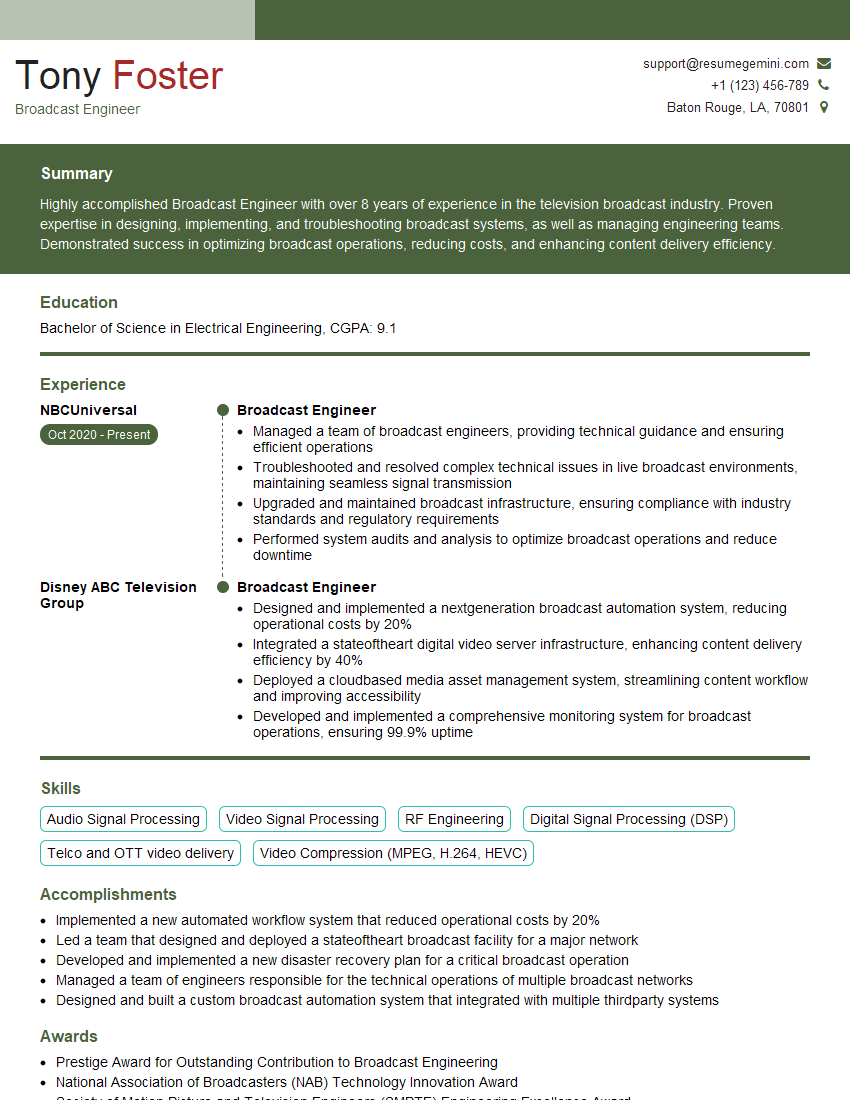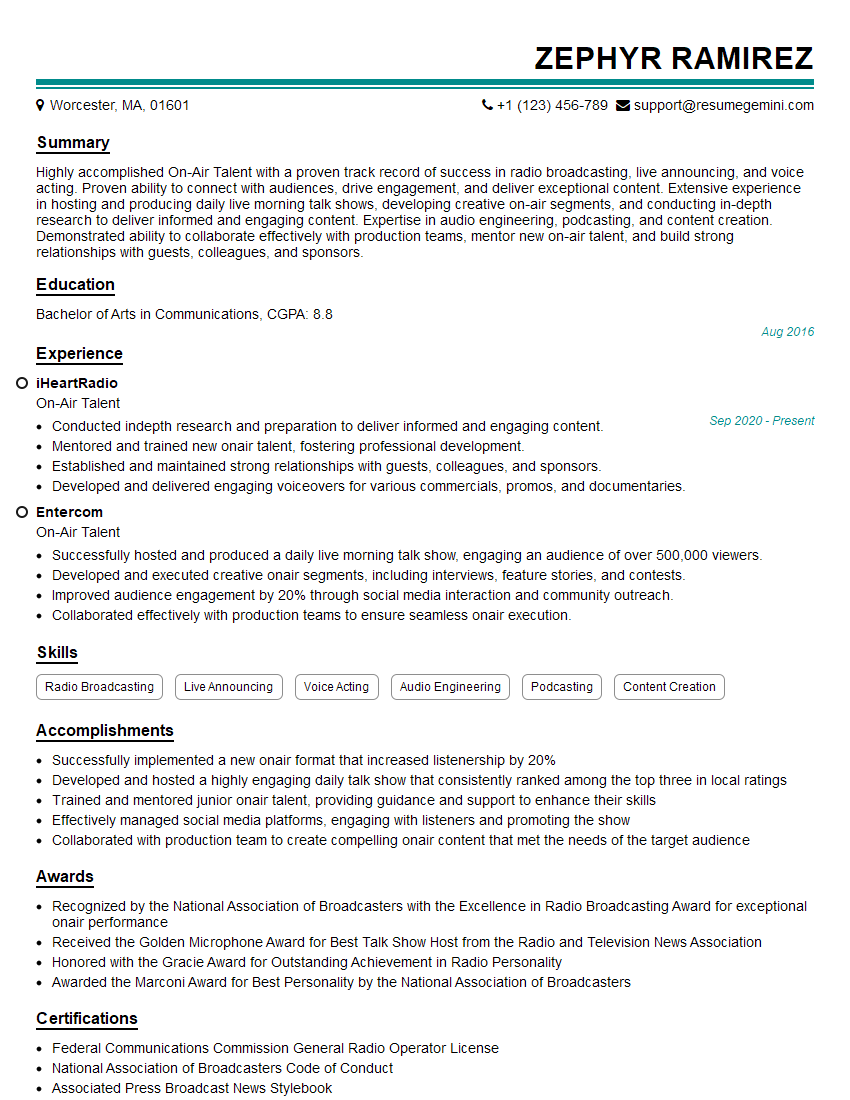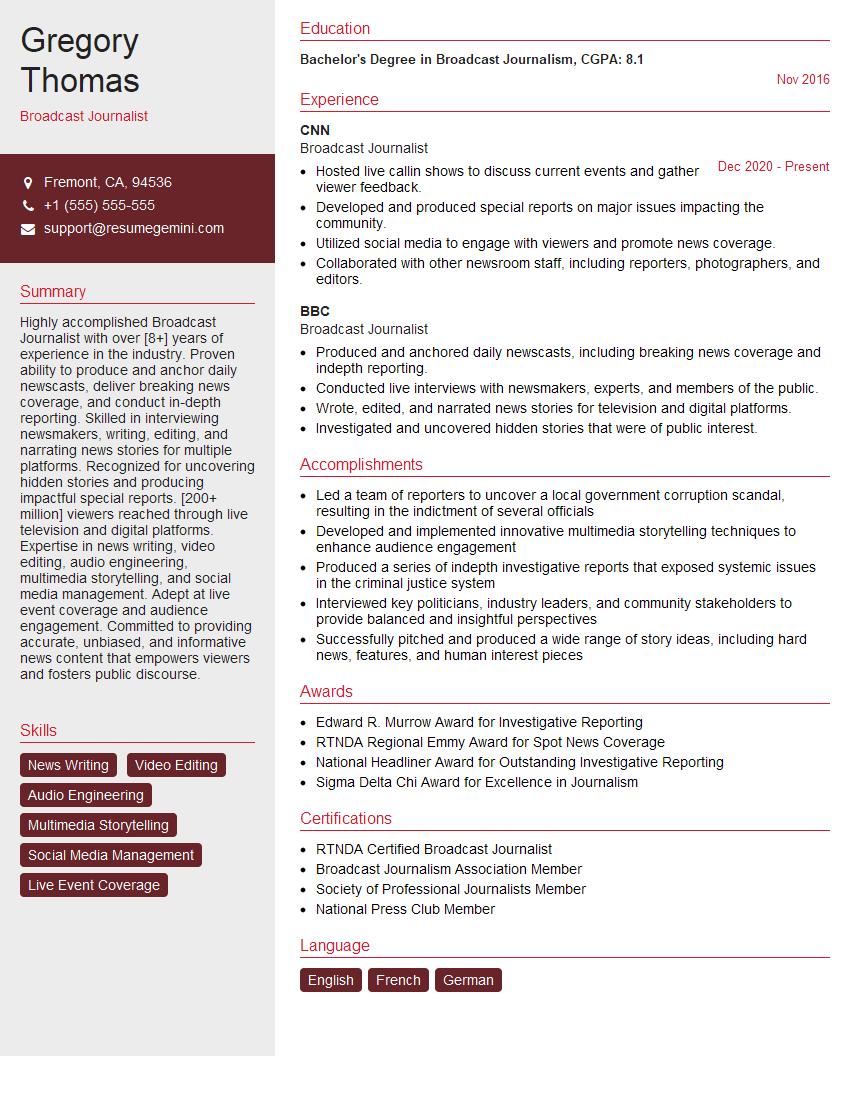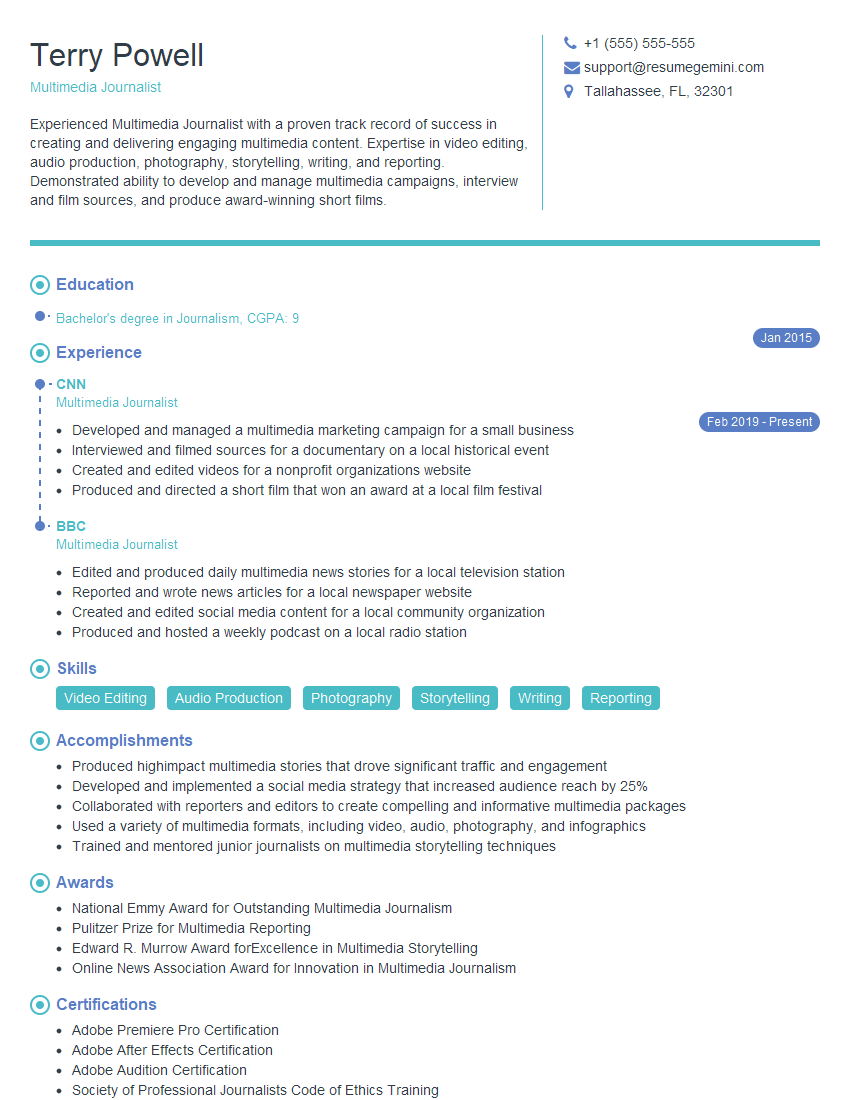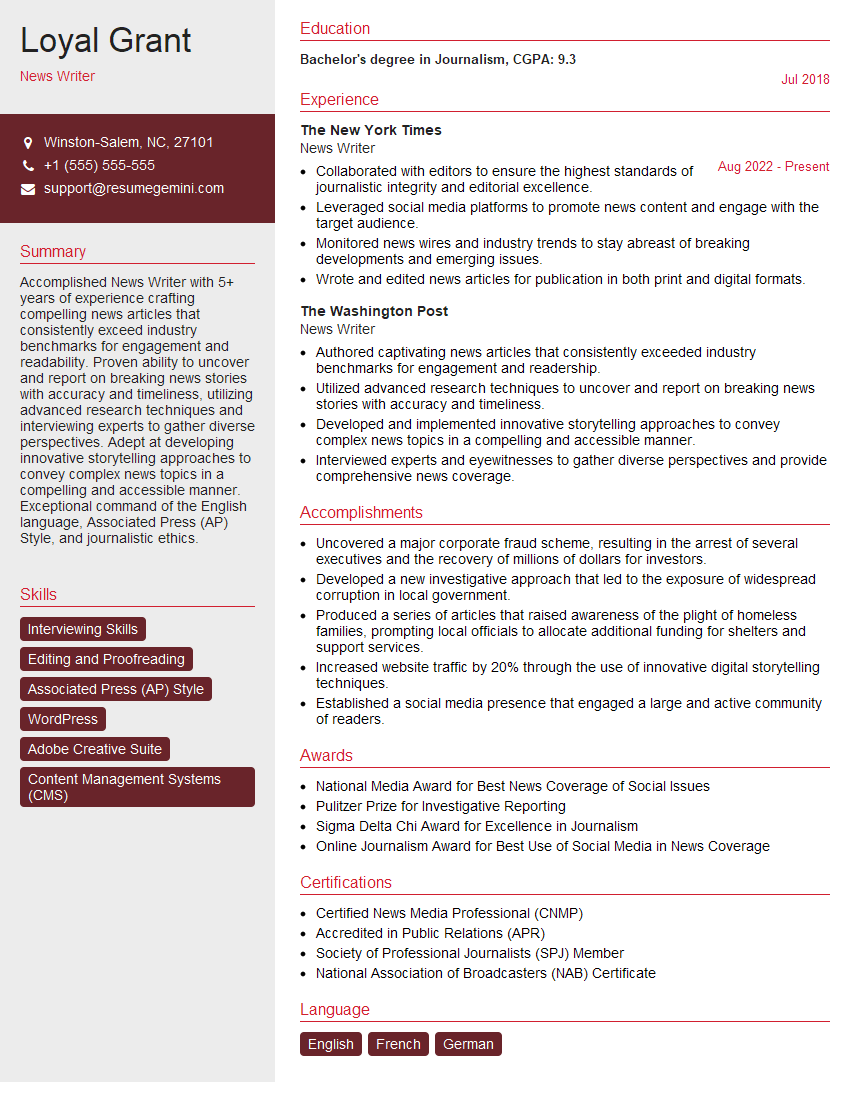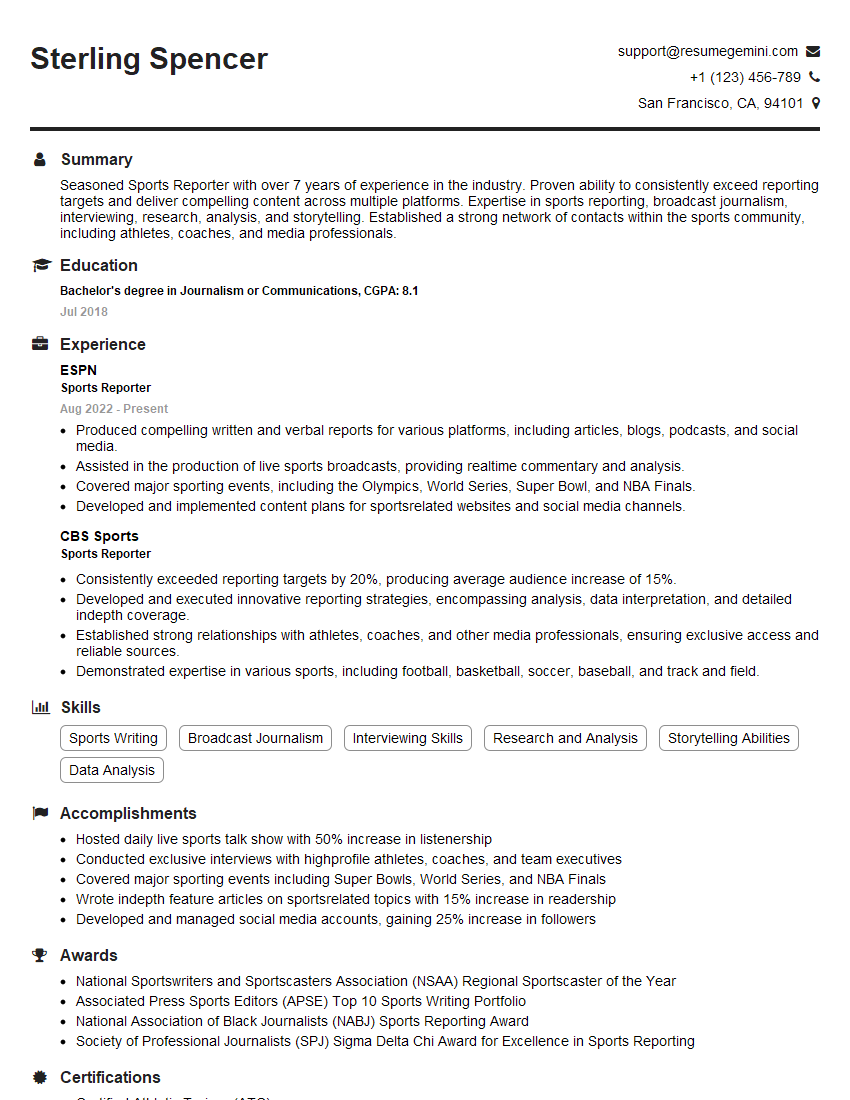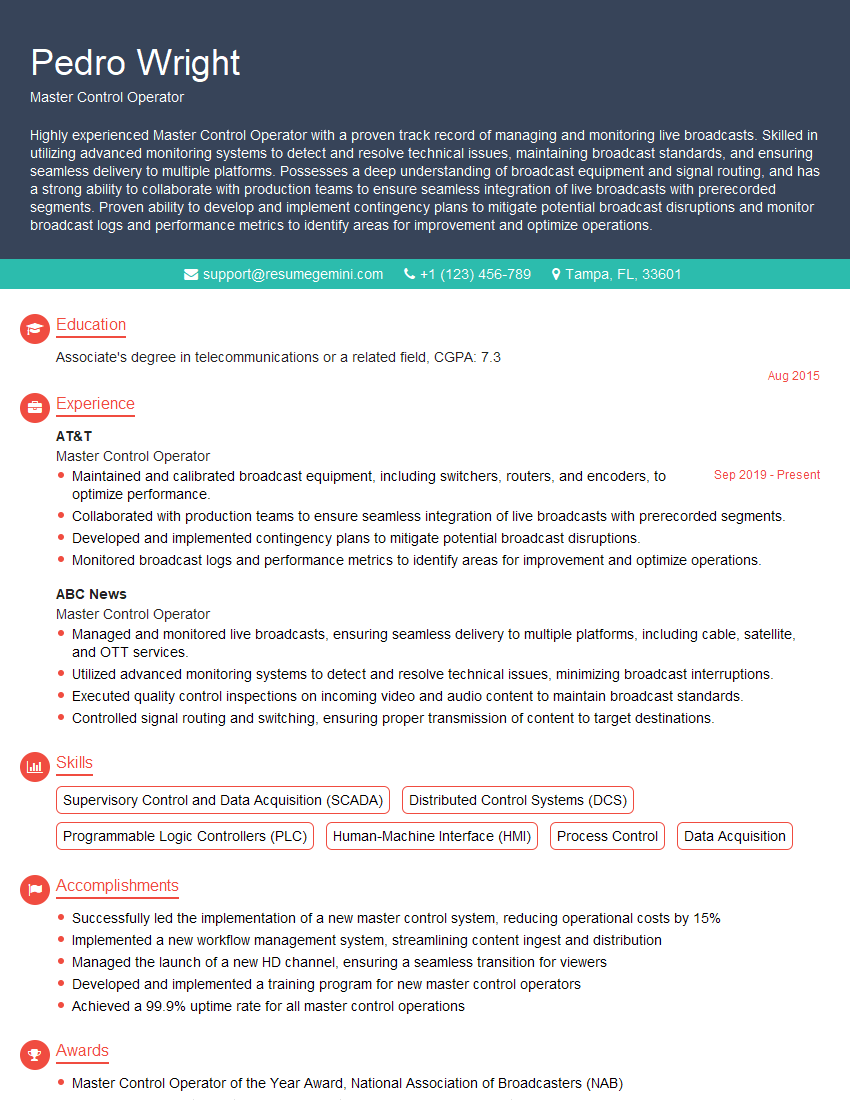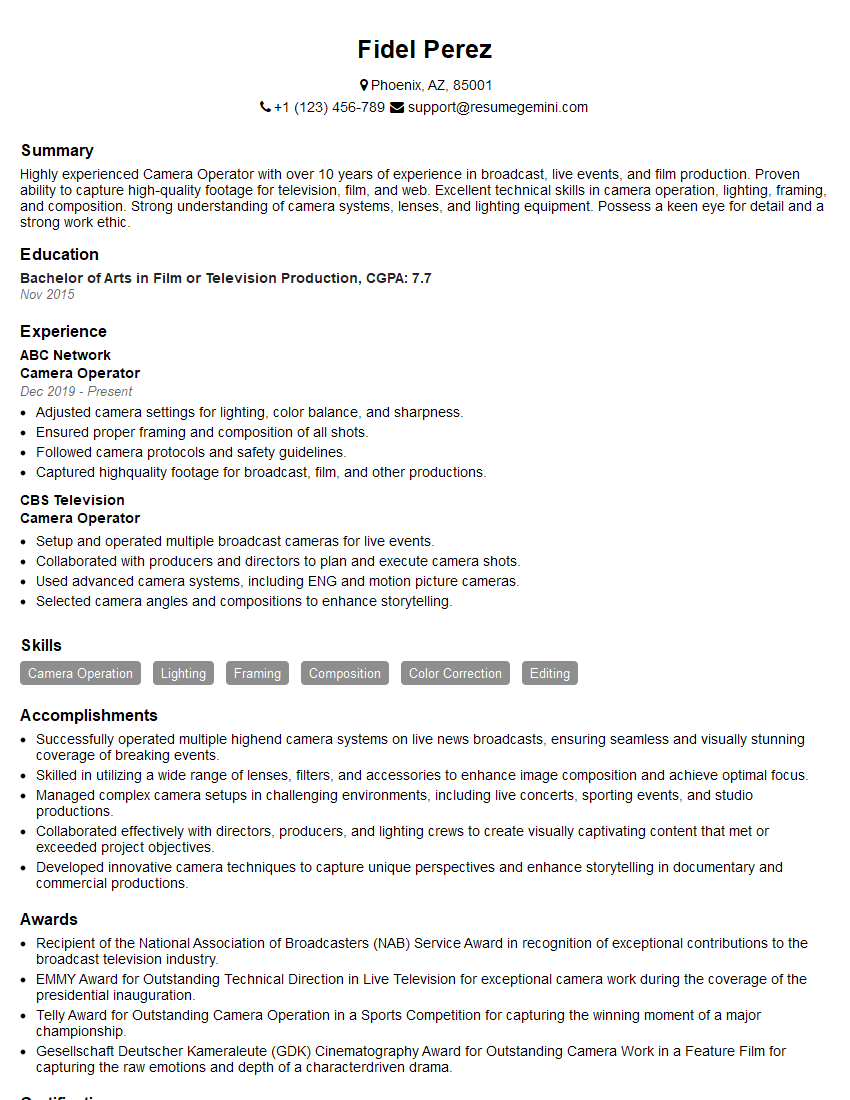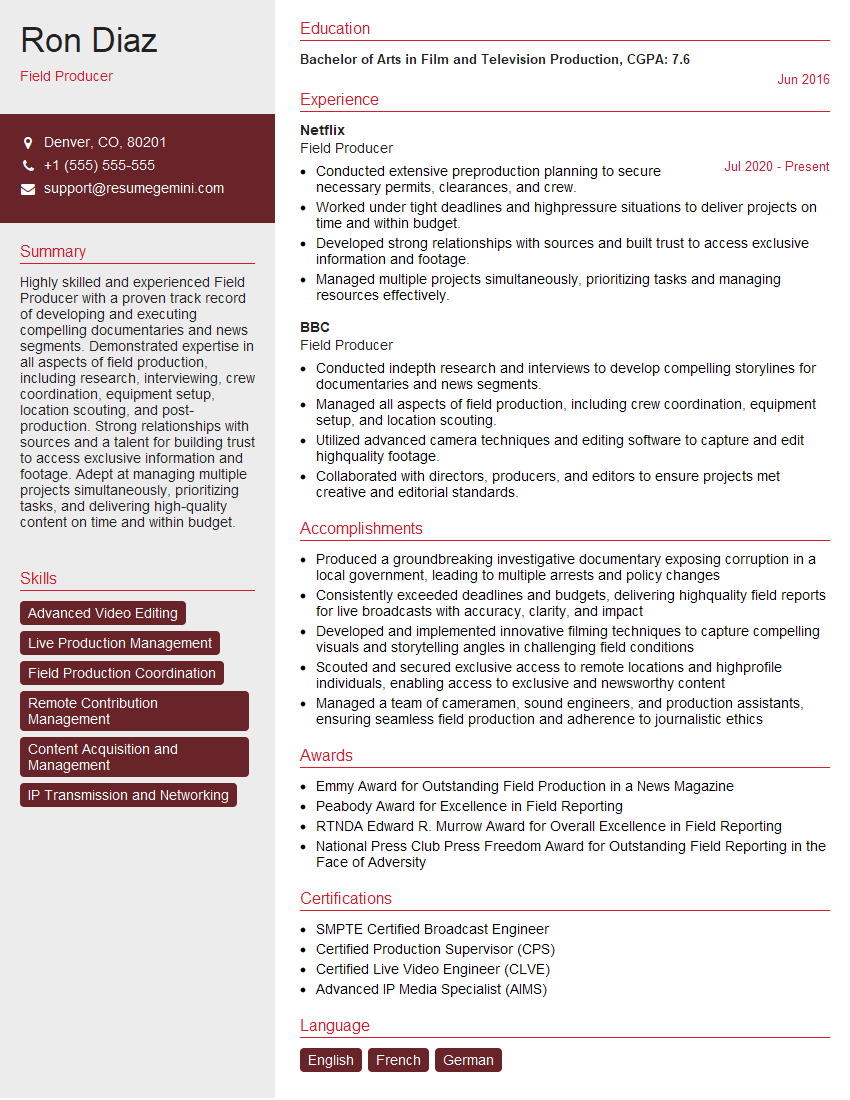Warning: search_filter(): Argument #2 ($wp_query) must be passed by reference, value given in /home/u951807797/domains/techskills.interviewgemini.com/public_html/wp-includes/class-wp-hook.php on line 324
Are you ready to stand out in your next interview? Understanding and preparing for Television Broadcasting interview questions is a game-changer. In this blog, we’ve compiled key questions and expert advice to help you showcase your skills with confidence and precision. Let’s get started on your journey to acing the interview.
Questions Asked in Television Broadcasting Interview
Q 1. Explain your experience with various camera systems and their functionalities.
My experience encompasses a wide range of camera systems, from traditional studio cameras like the Sony HDC-4300, known for its exceptional image quality and features ideal for high-end productions, to more compact and versatile ENG (Electronic News Gathering) cameras such as the Canon XA55, perfect for fast-paced news gathering or documentary work.
Each system offers unique functionalities. For instance, the HDC-4300 boasts advanced features like slow-motion capabilities and high dynamic range (HDR) for breathtaking visuals, while the XA55 prioritizes mobility and ease of use. Understanding the strengths and weaknesses of different camera systems—from their sensor size and image resolution to their lens options and connectivity—is crucial for selecting the right tool for the job. I’m proficient in operating and maintaining various camera accessories, including tripods, teleprompters, and various lens types, ensuring optimal image capture in diverse shooting environments. For example, during a recent live concert broadcast, the HDC-4300’s superior low-light performance was critical in capturing the stage’s ambiance, while the XA55’s portability allowed us to capture behind-the-scenes footage efficiently.
Q 2. Describe your proficiency in video editing software (e.g., Avid, Premiere Pro, Final Cut Pro).
I’m highly proficient in several professional video editing software packages, including Adobe Premiere Pro, Avid Media Composer, and Final Cut Pro. My expertise extends beyond basic editing; I’m adept at color correction, audio mixing, motion graphics creation, and advanced post-production techniques. Premiere Pro, for instance, is my go-to for its powerful color grading capabilities and extensive plugin support. I’ve used it extensively for creating high-impact promotional videos and editing complex multi-camera shoots. Avid Media Composer is essential for large-scale collaborative projects, its robust workflow perfectly suited for managing high volumes of footage. I used it in a recent documentary project where teamwork and efficient file management were paramount. Final Cut Pro’s intuitive interface and speed make it ideal for quick turnaround projects. I leverage the strengths of each platform based on project demands, often choosing Premiere Pro for its versatility and broad range of features.
Q 3. How do you ensure the quality of audio during a live broadcast?
Maintaining high-quality audio during a live broadcast is paramount. It involves a multifaceted approach starting with proper microphone selection. Different microphones—like lavalier mics for interviews, boom mics for capturing ambient sound, or shotgun mics for directional audio—are chosen based on the specific needs of the broadcast. Next, proper microphone placement and gain staging are critical to optimizing signal levels and minimizing noise. I always conduct thorough sound checks before going live to identify and address any potential issues. During a live broadcast, I constantly monitor audio levels and make adjustments as needed using a mixing console. I use techniques like compression and equalization to ensure a balanced and consistent audio experience for the viewer. Furthermore, using a dedicated audio engineer allows for even more detailed control and quality, particularly in complex productions. In one instance, during a live debate, a sudden surge in audience noise was immediately mitigated by adjusting the gain and utilizing noise gates, ensuring the candidates’ voices remained clearly audible.
Q 4. Detail your experience with live studio production, including directing and switching.
I have extensive experience in live studio production, encompassing all aspects from pre-production planning to on-air execution. My role frequently involves directing and switching live broadcasts using both traditional video switchers and more modern software-based solutions. This involves coordinating camera operators, talent, and technical crew to achieve a seamless on-air presentation. I’m comfortable working with various studio configurations, from single-camera setups to multi-camera productions with graphics, virtual sets, and special effects. For instance, in a recent morning show, I directed the flow of segments, cued camera shots, and communicated with the talent to ensure a smooth and engaging broadcast. My proficiency in using a switcher—whether it’s a traditional hardware-based system like a Ross Carbonite or a software-based solution like vMix—allows for real-time control and quick adaptation to changing circumstances during live productions. I understand the importance of storytelling and visual pacing to maintain audience engagement. I utilize various techniques such as cuts, dissolves, and wipes to create a dynamic visual experience.
Q 5. Explain your understanding of broadcast standards and regulations.
A thorough understanding of broadcast standards and regulations is crucial. This includes familiarity with technical standards, such as those defined by the FCC (Federal Communications Commission) in the US or Ofcom in the UK, which govern aspects like audio and video signal levels, transmission frequencies, and data encoding. It also involves awareness of legal and ethical considerations related to broadcasting, including defamation laws, copyright regulations, and fairness doctrines. I stay updated on these regulations through professional organizations and publications, ensuring compliance in all productions. For example, I’m very aware of the limitations on advertising during children’s programming and ensure these restrictions are observed meticulously. Understanding these guidelines is essential for producing responsible and legally compliant broadcasts.
Q 6. How do you manage time constraints and prioritize tasks in a fast-paced broadcast environment?
The broadcast environment is notoriously fast-paced, demanding efficient time management and prioritization. I employ several strategies to handle time constraints effectively. Pre-production planning plays a vital role; creating detailed run-of-show documents, shot lists, and technical schedules significantly reduces on-the-fly decision-making. I utilize efficient communication tools, both during rehearsal and live broadcast, to keep the team informed and coordinated. Furthermore, I prioritize tasks based on their urgency and importance, focusing on critical elements first. During a live news bulletin, for instance, I prioritize ensuring the timely delivery of essential news updates over non-critical segments, adapting to breaking news with speed and precision. Problem-solving and adaptability are key; I remain calm under pressure and quickly resolve unexpected issues without disrupting the flow of the broadcast.
Q 7. Describe your experience with troubleshooting technical issues during a live broadcast.
Troubleshooting technical issues during a live broadcast requires quick thinking and problem-solving skills. My approach is systematic. I first identify the nature of the problem—is it audio, video, or something else? I then use a methodical process of elimination, checking all possible causes. If the audio is cutting out, for example, I would check microphone connections, audio levels, and mixer settings systematically. I work closely with the technical team to pinpoint the root cause and implement the fastest solution. While working on a live sports event, a sudden camera malfunction occurred. Using my knowledge of backup systems, I quickly switched to a standby camera minimizing disruption. Experience allows for proactive problem prevention; I run comprehensive checks and ensure backups are always in place. Detailed post-broadcast reviews help identify areas for improvement to reduce future technical issues.
Q 8. How familiar are you with different video formats and codecs?
My familiarity with video formats and codecs is extensive. Understanding these is fundamental to television broadcasting. We’re dealing with capturing, encoding, transmitting, and decoding video signals, and the right choice significantly impacts quality, file size, and bandwidth requirements.
- Common Formats: I’m proficient with formats like MPEG-2 (used extensively in broadcast television), H.264 (AVC), a highly efficient codec used in many digital platforms, and the newer HEVC (H.265), which offers even better compression ratios. I also have experience with codecs like ProRes (used for high-quality editing) and DNxHD (another professional editing codec).
- Considerations: When choosing a format and codec, factors like resolution (e.g., SD, HD, 4K, 8K), bitrate (the amount of data transmitted per second, affecting quality), and compatibility with different equipment and platforms are crucial. For instance, a high-bitrate H.264 stream might be suitable for a high-definition broadcast but might be too large for online streaming, requiring a lower bitrate or even a switch to HEVC.
- Practical Application: In my previous role, I optimized our encoding settings to reduce file sizes without significantly sacrificing picture quality, leading to lower storage and transmission costs, while ensuring compatibility with our various distribution channels, including cable, satellite, and online streaming services.
Q 9. Explain your understanding of the role of a technical director in a live broadcast.
The Technical Director (TD) is the heart of a live broadcast’s technical operations. They’re responsible for the overall visual presentation of the program, acting as the director’s eyes and ears in the control room. Think of them as the conductor of a complex orchestra.
- Responsibilities: The TD operates the video switcher, selecting which camera feeds are on air, seamlessly transitioning between shots, and executing the director’s vision. They work closely with the director, camera operators, video engineers, and graphics operators, ensuring a smooth and technically flawless broadcast.
- Decision-Making: The TD makes split-second decisions. They might need to quickly switch to a backup camera if one fails or use special effects like slow motion or wipes to enhance the visual flow of the program.
- Technical Expertise: A skilled TD has deep knowledge of video switching technology, cameras, and the overall technical infrastructure of the broadcast environment. They are problem-solvers capable of troubleshooting issues rapidly and efficiently in the often high-pressure environment of a live production.
- Example: In a news broadcast, the TD would quickly switch to a cutaway shot if the anchor stumbled on a word, preventing the audience from noticing the slip-up. They’d also seamlessly integrate graphics, such as lower thirds with names and titles, into the production.
Q 10. Describe your experience with remote broadcasting and its challenges.
My experience with remote broadcasting has grown significantly in recent years. The technology has advanced, making high-quality remote broadcasts more feasible than ever before, but challenges remain.
- Advantages: Remote broadcasting offers cost savings by reducing the need to send large crews to different locations. It allows for wider access to talent and locations. However, it requires robust and reliable internet connectivity at each remote location.
- Challenges: The biggest hurdles are network latency (delay), ensuring sufficient bandwidth, and managing potential connectivity issues. Poor internet connectivity can cause pixelation, dropped frames, or even complete signal loss. Synchronization between different locations also needs careful planning and monitoring.
- Solutions: We use high-quality, bonded cellular internet connections and IP video transmission to mitigate connectivity issues. Careful testing beforehand is critical to identify and resolve potential problems before the live broadcast. Redundant systems and backup strategies are essential for disaster recovery.
- Example: In a recent remote interview, we experienced a momentary internet outage at the remote location. Our pre-planned backup system, using a secondary internet connection, seamlessly switched over, ensuring no disruption to the broadcast.
Q 11. How do you handle unexpected events or technical malfunctions during a live broadcast?
Handling unexpected events during a live broadcast requires a combination of preparedness, quick thinking, and teamwork. It’s all about having a plan B, and sometimes, a plan C!
- Preparedness: Regular equipment checks and rehearsals are essential. We also have backup equipment readily available for critical components.
- Quick Thinking: If a problem arises, the team needs to react immediately. The director might call for a cutaway to a pre-recorded segment, the TD might switch to a backup camera, and the floor crew might address a lighting malfunction.
- Teamwork: Effective communication between all members of the production team is critical. Clear communication procedures and a well-defined chain of command help ensure a coordinated and efficient response.
- Example: During a live sporting event, a sudden power outage occurred at the stadium. We quickly switched to our studio backup feed, which showed highlights and interviews from earlier in the event, minimizing disruption for viewers.
Q 12. Explain your knowledge of signal flow in a television broadcast system.
Signal flow in a television broadcast system is the path a video and audio signal takes from its source to the viewer. Understanding this flow is essential for troubleshooting and optimizing the entire broadcast chain.
A simplified example is as follows:
- Camera: The video signal originates from a camera.
- Camera Control Unit (CCU): The signal is sent to the CCU, which allows the operator to adjust camera settings.
- Video Switcher: The CCU sends the signal to the video switcher, which selects which camera feeds are on-air.
- Graphics System: Graphics are added from a graphics system.
- Audio Mixer: Sound is mixed in the audio mixer.
- Master Control Room: The mixed video and audio signals are sent to the Master Control Room.
- Transmission: The signal is transmitted to broadcast towers and then to viewers via various channels (cable, satellite, internet).
Each step involves specific equipment and processes. Understanding the signal path allows for effective troubleshooting, identifying bottlenecks, and optimizing the overall quality of the broadcast. For example, if there is a problem with the audio during a live broadcast, knowing the signal flow helps pinpoint the problem —is it with the microphone, mixer, or transmission?
Q 13. Describe your experience with graphics and character generation in television production.
My experience encompasses various aspects of graphics and character generation (CG) in television production. These elements are crucial for enhancing visual appeal and providing essential information.
- Types of Graphics: I’ve worked with lower thirds (names and titles on screen), full-screen graphics, animated logos, and even virtual sets. The choice depends on the program’s style and needs.
- Software: I’m familiar with industry-standard CG software such as Adobe After Effects, Avid Media Composer, and broadcast-specific systems like Vizrt and Ross Video.
- Workflow: Typically, graphics are created beforehand, but some systems allow for real-time creation and insertion. Close collaboration with the graphics operator during live broadcasts is essential for smooth integration.
- Example: In a news broadcast, we use lower thirds to identify the speakers and locations, and we might use full-screen graphics for weather reports or election results. During a sports program, we’d use animated graphics to track game statistics.
Q 14. How familiar are you with different microphone types and their applications?
Different microphone types are chosen based on their characteristics and the sound they capture best. It’s a crucial aspect of good audio, directly impacting the viewer experience.
- Dynamic Microphones: Robust, reliable, and relatively inexpensive, they handle high sound pressure levels well. These are commonly used for live performances and interviews.
- Condenser Microphones: More sensitive and capture a wider range of frequencies, offering better detail. Ideal for recording delicate sounds, they often need external power (phantom power).
- Lavaliere (Lavalier) Microphones: Small microphones clipped onto clothing, ideal for interviews and situations where minimizing microphone visibility is necessary.
- Shotgun Microphones: Highly directional mics that capture sound from a narrow area, excellent for isolating sounds in noisy environments. Commonly used for filming outdoors or in spaces with distracting ambient noise.
- Boom Microphones: A type of microphone on a pole that allows for more flexible positioning and sound isolation.
- Practical Application: For a live musical performance, dynamic microphones might be used for loud instruments such as drums and electric guitars, while condenser microphones would be preferred for quieter vocals or acoustic instruments. A news interview might use a lavalier microphone to keep the microphone unobtrusive.
Q 15. Explain your understanding of the importance of color correction and grading in television.
Color correction and grading are crucial in television broadcasting because they significantly impact the visual storytelling and viewer experience. Color correction aims to fix inconsistencies and inaccuracies in the footage, ensuring colors are true-to-life and balanced. Grading, on the other hand, is a more artistic process, where color is manipulated to create a specific mood, atmosphere, or style. Think of it like this: correction is fixing a chipped paint can, while grading is choosing the paint color for the entire room.
For instance, footage shot on a cloudy day might appear dull and desaturated. Color correction would adjust the whites and blacks to ensure the image is properly exposed and balanced. Grading could then be used to subtly shift the overall tone towards a warmer palette, creating a more comforting and nostalgic feel, or towards a cooler palette for a more dramatic and serious effect. These processes are critical because viewers unconsciously respond to color, and properly graded footage enhances their emotional engagement with the content.
Different genres of television also demand unique approaches. A vibrant, saturated look might be ideal for a children’s program, while a muted, desaturated palette might suit a documentary or serious drama. Ultimately, the goal is to ensure the visuals align with the overall narrative and enhance the storytelling.
Career Expert Tips:
- Ace those interviews! Prepare effectively by reviewing the Top 50 Most Common Interview Questions on ResumeGemini.
- Navigate your job search with confidence! Explore a wide range of Career Tips on ResumeGemini. Learn about common challenges and recommendations to overcome them.
- Craft the perfect resume! Master the Art of Resume Writing with ResumeGemini’s guide. Showcase your unique qualifications and achievements effectively.
- Don’t miss out on holiday savings! Build your dream resume with ResumeGemini’s ATS optimized templates.
Q 16. Describe your experience with working with news crews in the field.
My experience working with news crews in the field has been extensive and rewarding. I’ve collaborated with teams on breaking news stories, live broadcasts, and pre-recorded segments. This work often requires quick thinking and adaptability. For example, on one occasion, we were covering a major storm and had to quickly adjust our lighting and sound equipment due to unexpected weather conditions. Maintaining communication and clear directives under these high-pressure situations is vital to ensure quality footage and a safe working environment. The field is where the story comes to life, and we need to capture the nuances of emotion and event as precisely and effectively as possible.
I’ve developed strong relationships with field crews through clear communication, mutual respect, and a shared understanding of our goals. Being proactive and anticipating potential problems, such as power outages or equipment malfunctions, enables smoother production processes. I find providing clear technical instructions and being available for immediate support contributes to a positive and efficient working relationship.
Q 17. How do you maintain professionalism and composure under pressure?
Maintaining professionalism and composure under pressure is paramount in television broadcasting. It’s a high-stakes environment with tight deadlines and unexpected challenges. My approach involves several strategies. Firstly, thorough preparation is key. Understanding the technical aspects of the equipment, the production schedule, and the overall broadcast plan significantly reduces stress. Secondly, I prioritize clear communication and collaboration with the team. Openly discussing concerns and delegating tasks effectively helps to share the workload and fosters a supportive environment.
Furthermore, I rely on deep breathing techniques and mindfulness practices to manage anxiety. Taking short breaks when needed to center myself helps maintain focus and clarity. Finally, it is crucial to always stay calm and reassuring to the team. A calm leader can help maintain focus and efficiency under pressure, even during technical difficulties. This ultimately delivers a more polished and professional final product.
Q 18. Explain your experience with various lighting techniques and equipment.
My experience encompasses a wide range of lighting techniques and equipment, from traditional three-point lighting setups to more advanced techniques like high-dynamic-range (HDR) imaging. I’m proficient in using various lighting instruments, including tungsten, fluorescent, LED, and HMI lights. Understanding the color temperature and intensity of different light sources is crucial for achieving the desired look and feel of a scene. For instance, using warm-toned tungsten lights can create a nostalgic mood, while cool-toned LED lights can provide a more modern or dramatic feel.
I’m experienced with various lighting modifiers, such as softboxes, umbrellas, and grids, that help shape and control the light. I’ve worked with both practical and artificial lighting sources and know how to effectively integrate them for a seamless and visually appealing result. For example, in a studio environment, I might use a key light, fill light, and backlight to create depth and dimension. In a field setting, I’ll need to adapt to available lighting conditions, using reflectors, diffusion panels, and other tools to enhance the existing light.
Q 19. Describe your understanding of storytelling and its application in television broadcasting.
Storytelling is the heart of television broadcasting. It’s about conveying information or emotions in a compelling and engaging manner. In television, storytelling involves structuring the narrative, selecting the right visuals, and using sound and music to enhance the emotional impact. Think of it as a conversation between the broadcaster and the audience—a successful story will maintain the attention and interest of the audience.
I utilize various storytelling techniques, such as establishing clear characters and conflicts, building suspense, and creating memorable moments. The visual elements – camera angles, editing techniques, and pacing – play a crucial role in shaping the narrative. For example, a close-up shot can emphasize emotion, while a wide shot can establish setting. Sound design, including music and sound effects, further complements the visuals and enhances the emotional impact of the story. The overall goal is to create a narrative that resonates with the audience and leaves a lasting impression.
Q 20. How do you collaborate effectively with a team in a broadcast environment?
Collaboration is essential in a broadcast environment. Effective teamwork involves clear communication, mutual respect, and a shared understanding of the goals. I always start by clearly defining roles and responsibilities, ensuring each team member knows their contributions and how they fit into the overall production process. This involves regular meetings and open communication channels to keep everyone informed and on the same page.
I encourage open feedback and actively listen to the ideas and concerns of my colleagues. Constructive criticism and open discussion are vital for improving the quality of the broadcast. Building a positive and supportive team environment where people feel comfortable sharing their ideas and concerns is crucial. This also involves recognizing and celebrating team achievements, fostering a sense of camaraderie and shared accomplishment. Working collaboratively creates a more effective workflow and ultimately ensures a successful broadcast.
Q 21. Explain your experience with post-production processes, including editing and mastering.
My post-production experience includes a comprehensive understanding of editing and mastering. Editing involves selecting and assembling the best footage, constructing the narrative, and refining the visual and audio elements. I’m proficient in various editing software and techniques, such as cutting, transitions, color correction, and audio mixing. This phase requires meticulous attention to detail, ensuring a smooth and engaging flow of the narrative.
Mastering involves the final stages of post-production, where the audio and video are optimized for broadcast. This includes color grading, audio mastering, and encoding the final product in the appropriate format for the target platform. Mastering is crucial for achieving the highest possible quality and ensuring the broadcast meets industry standards. For example, mastering might involve adjusting the overall levels of audio to ensure clarity and avoiding distortion, while maintaining the intended tonal balance across the entire broadcast. The process requires a critical eye and ear, ensuring a consistent and high-quality final product.
Q 22. How do you ensure the accuracy and integrity of news content?
Ensuring the accuracy and integrity of news content is paramount in broadcasting. It’s a multi-faceted process that begins even before the story hits the air. We rely on a robust fact-checking system involving multiple layers of verification.
- Source Verification: We rigorously vet all sources, cross-referencing information from multiple independent and credible sources. For example, if we receive information from a single source, we’d attempt to corroborate it with official statements, public records, or other reputable news organizations.
- Multiple Fact-Checkers: Stories are reviewed by multiple journalists and editors, each with their own expertise, before broadcast. This helps to identify potential biases, inaccuracies, and omissions.
- Evidence-Based Reporting: We emphasize evidence-based reporting, prioritizing verifiable facts and data over speculation or assumptions. This means supporting claims with concrete evidence, such as statistics, documents, or eyewitness testimony.
- Corrections and Clarifications: We have a clear process for issuing corrections and clarifications if errors are discovered after broadcast. This commitment to transparency builds trust with our audience.
- Editorial Standards and Guidelines: We adhere to a strict set of editorial standards and guidelines, ensuring objectivity, fairness, and balance in our reporting. This includes guidelines on avoiding conflict of interest and maintaining journalistic ethics.
Think of it like building a strong house – each step, from sourcing materials (information) to construction (verification) and inspection (fact-checking), contributes to the overall strength and stability of the final product (broadcast).
Q 23. Describe your experience with using teleprompters and delivering scripts effectively.
Teleprompters are an essential tool for delivering scripts smoothly and professionally. My experience spans various news formats, from live breaking news updates to pre-recorded segments. I’ve mastered the skill of reading from a teleprompter while maintaining eye contact with the camera and engaging the audience. The key is practice and technique.
- Speed and Rhythm: I can adjust my reading speed to match the pace and tone of the story, ensuring a natural flow.
- Eye Contact: I maintain eye contact with the camera, avoiding the common trap of constantly looking down at the prompter. This creates a more engaging experience for the viewer.
- Inflection and Emphasis: I use appropriate inflection and emphasis to highlight key points and convey emotion effectively. It’s about more than just reading the words; it’s about telling a story.
- Improvisation: I’m also adept at seamlessly incorporating ad-libs or improvising on-air to address unexpected developments or situations, while staying true to the overall message.
For example, during a live broadcast of a breaking news story, I once had to improvise a transition smoothly when a crucial piece of information became available unexpectedly. My experience with teleprompters allowed me to smoothly integrate this new information without interrupting the flow of the news bulletin.
Q 24. Explain your understanding of different audio mixing techniques.
Audio mixing is the art of combining and balancing different audio sources to create a clear, engaging, and balanced soundscape. It’s crucial for creating a professional broadcast. My understanding encompasses various techniques:
- Equalization (EQ): This involves adjusting the frequency balance of individual audio sources to enhance clarity and reduce muddiness. For instance, boosting the higher frequencies of a voice can make it sound crisper, while cutting low frequencies in a musical track can prevent it from overwhelming other elements.
- Compression: This technique reduces the dynamic range of an audio signal, making quieter parts louder and louder parts quieter. It helps create a more consistent and polished sound, especially important for voices and musical elements.
- Reverb and Delay: These effects simulate the acoustic environment of a space. Adding a touch of reverb can make a voice sound richer and warmer, while delay can create interesting echoes and special effects. We use these carefully to enhance, not detract, from the overall audio experience.
- Panning: This involves positioning audio sources within the stereo field, placing them left, right, or center. This helps create a sense of space and dimension, making the audio more immersive.
Consider a news interview: we’d use EQ to make the voices clear, compression to maintain consistent levels, and panning to position the interviewer and interviewee in distinct places in the stereo field for better audience perception. This allows viewers to easily discern between speakers.
Q 25. How familiar are you with the use of social media in television broadcasting?
Social media plays a significant role in modern television broadcasting. It’s no longer enough to simply broadcast content; we must actively engage with audiences online. My familiarity with social media in broadcasting is extensive.
- Promoting Content: We utilize platforms like Twitter, Facebook, and Instagram to promote our shows and news stories, reaching a wider audience and driving viewership.
- Audience Engagement: Social media offers a direct line of communication with our viewers. We monitor social media for feedback, respond to comments and queries, and foster community engagement.
- Real-time Updates: During breaking news events, social media can be used to provide real-time updates and interact with the audience, providing a truly dynamic viewing experience.
- Interactive Content: We leverage interactive features like polls, Q&A sessions, and live streams to enhance audience participation and create a more engaging broadcast experience.
- Monitoring Public Opinion: We use social listening tools to gauge public opinion on various topics, and this insight is useful in shaping our editorial strategy and content.
For example, during a major local election, we used a Twitter hashtag to encourage viewer participation in a real-time poll, which was then displayed on air. This boosted engagement and allowed us to provide immediate feedback on public opinion during the broadcast.
Q 26. Describe your experience with creating and managing broadcast schedules.
Creating and managing broadcast schedules is a complex process requiring careful planning and coordination. My experience involves optimizing scheduling to maximize viewership, adhere to regulatory requirements, and integrate various program types.
- Audience Analysis: I analyze viewership data to understand audience preferences and program the schedule accordingly, optimizing for peak viewing times.
- Program Sequencing: I strategically sequence programs to create a balanced and engaging schedule, considering genre, target audience, and runtime.
- Commercial Integration: I manage the integration of commercial breaks, ensuring compliance with advertising regulations and maximizing revenue generation.
- Scheduling Software: I am proficient in using various scheduling software packages to optimize the schedule, manage resources, and ensure timely execution.
- Contingency Planning: I develop contingency plans to deal with unexpected issues, such as program delays or technical failures, ensuring the smooth flow of the schedule.
Imagine scheduling a marathon of sporting events alongside news programs and local dramas; I would consider the expected audience for each event and place them strategically within the broadcast day, making the most effective use of the available time and resources.
Q 27. How do you adapt to changing technologies and trends in television broadcasting?
The television broadcasting industry is constantly evolving, and adapting to new technologies and trends is crucial for success. I actively embrace this evolution by:
- Continuous Learning: I stay up-to-date with industry publications, attend workshops and conferences, and participate in online courses to enhance my skills and knowledge.
- Experimentation with New Technologies: I actively explore and experiment with new technologies, such as 4K broadcasting, HDR, and immersive audio, to understand their potential benefits and limitations.
- Embracing New Platforms: I embrace the use of new broadcast platforms and streaming services, optimizing our content for these various platforms to reach a wider and more diverse audience.
- Staying Informed on Industry Best Practices: I keep abreast of industry best practices, ensuring our production workflows and broadcasting standards remain aligned with current standards and developments.
For example, I’ve been instrumental in transitioning our broadcast operations from standard definition to high definition, and then further to 4K UHD, by leading the training of staff and overseeing the technical upgrades required. This ensures our broadcasts remain current and competitive.
Q 28. Explain your understanding of copyright and intellectual property rights in broadcasting.
Understanding copyright and intellectual property rights is vital in broadcasting. It’s crucial to ensure that all content used in our broadcasts is legally cleared and respects the rights of copyright holders.
- Copyright Clearance: Before using any copyrighted material, such as music, footage, or images, we obtain appropriate licenses or permissions from the copyright owners. This ensures legal compliance and avoids potential infringement issues.
- Fair Use Considerations: I am well-versed in understanding the concept of ‘fair use’ and its limitations, ensuring that any use of copyrighted material falls within the parameters of legal allowance.
- Attribution and Acknowledgement: We always properly attribute and acknowledge the sources of all copyrighted material used, giving due credit to the creators.
- Contract Negotiation: I am involved in negotiating contracts with content providers and securing necessary licensing agreements to ensure the legal and ethical usage of content.
- Compliance with Regulations: We ensure our broadcasts are compliant with all relevant copyright laws and regulations, both nationally and internationally.
For instance, before using a popular song in a promotional video, we always secure the necessary synchronization license from the music publisher and performing rights organization. This avoids legal pitfalls and maintains our reputation for ethical practices.
Key Topics to Learn for Your Television Broadcasting Interview
- News Production Workflow: Understand the entire process from story pitching and scriptwriting to live broadcasting and post-production. Consider the challenges of working under pressure and meeting tight deadlines.
- Technical Proficiency: Demonstrate familiarity with studio equipment (cameras, microphones, switchers, teleprompters), editing software (e.g., Adobe Premiere Pro, Avid Media Composer), and broadcast standards (e.g., aspect ratios, audio levels).
- On-Air Presence and Communication: Practice delivering clear, concise, and engaging presentations. Reflect on how you would handle unexpected situations, like technical difficulties or difficult interviews.
- Storytelling and Journalism Ethics: Discuss your understanding of journalistic principles, including accuracy, fairness, and objectivity. Be prepared to explain how you craft compelling narratives for a television audience.
- Content Creation and Formatting: Explore different television formats (news, documentaries, features, sports) and the unique considerations for each. Consider how to adapt storytelling techniques for diverse audiences.
- Teamwork and Collaboration: Highlight your experience working effectively in a team environment, coordinating with producers, directors, and other crew members. Discuss conflict resolution strategies.
- Current Events and Industry Trends: Stay updated on the latest trends in television broadcasting, including technological advancements and evolving media landscapes. Be prepared to discuss current affairs and their relevance to the industry.
Next Steps
Mastering television broadcasting opens doors to a dynamic and rewarding career, offering opportunities for creativity, storytelling, and impactful communication. To significantly increase your job prospects, it’s crucial to present yourself effectively. An ATS-friendly resume is essential in today’s competitive job market. We highly recommend using ResumeGemini to craft a professional and impactful resume that highlights your skills and experience. ResumeGemini provides tools and examples specifically tailored to the Television Broadcasting field, enabling you to create a resume that gets noticed.
Explore more articles
Users Rating of Our Blogs
Share Your Experience
We value your feedback! Please rate our content and share your thoughts (optional).
What Readers Say About Our Blog
Hi, I represent a social media marketing agency that creates 15 engaging posts per month for businesses like yours. Our clients typically see a 40-60% increase in followers and engagement for just $199/month. Would you be interested?”
Hi, I represent an SEO company that specialises in getting you AI citations and higher rankings on Google. I’d like to offer you a 100% free SEO audit for your website. Would you be interested?

